Welcome to Comics Are My Religion, a look at theology through the lens of comic books. There are some basic ground rules about engaging in respectful dialogue about religion in this column. Be warned, if you haven’t read the series discussed below, you might want to go read it and come back, as this column may contain spoilers!
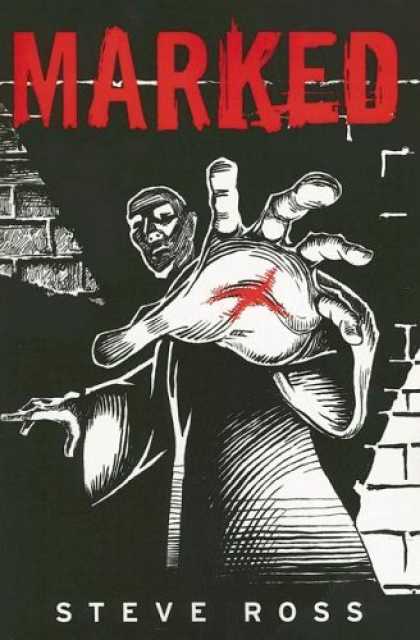
“I’m going to die, aren’t I?”
“Not at first.”
This month, I decided to feature a book that may be foreign to many of you. In fact, I wasn’t planning on featuring it this soon, until a 70-year-old matriarch of my church walked into my office and plopped it on my desk. I had read it years ago, when it first came out, but I was surprised to see the head of my Altar Guild with a copy…and a signed copy, no less!
Marked by Steve Ross, published in 2005, made the rounds on the Christian art & media websites because Ross capitalized on the mainstream popularity of Jesus & Christianity in the media, with such films as Mel Gibson’s The Passion of the Christ (2004). Religious comics were nothing new in 2005, with fundamental evangelical comics published by Jack Chick (“chick tracts”) for decades; even Marvel and DC have published graphic interpretations of the Bible. In the Episcopal Church, of which I belong, Ross gained much notoriety because he himself is an Episcopalian, and Marked was even published by Seabury Press, which is an Episcopal publisher. Marked is the first of such graphic novels published by Seabury.
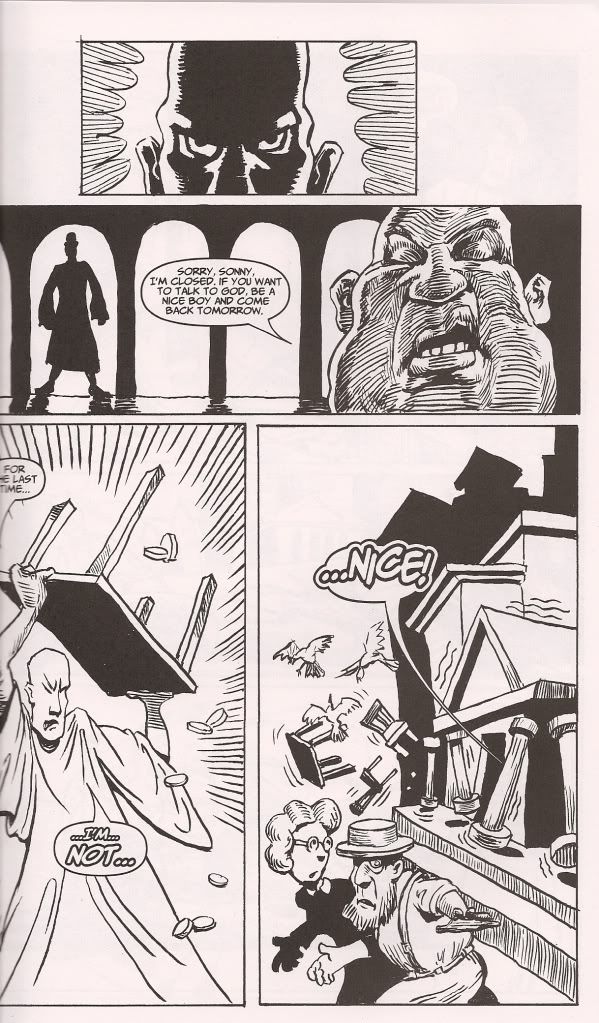 Today, you can find Marked marketed in Christian circles to teenagers, as if adults would find no value in such a book. In fact, even the head of my Altar Guild put it in my office because that’s also where the teens have their Sunday School class, and she thought it might catch their eyes. However, Ross’s book is a much denser, much more symbolic tale, that even the biblical scholar would appreciate.
Today, you can find Marked marketed in Christian circles to teenagers, as if adults would find no value in such a book. In fact, even the head of my Altar Guild put it in my office because that’s also where the teens have their Sunday School class, and she thought it might catch their eyes. However, Ross’s book is a much denser, much more symbolic tale, that even the biblical scholar would appreciate.
Marked is Ross’s visual interpretation of the Gospel According to Mark. A quick lesson in Mark: while it is the second Gospel (or “good news”) found in the New Testament, it is believed by most scholars to be the earliest written Gospel. In fact, most believe that Mark was used as a primary source for two of the other gospels, Matthew and Luke. Perhaps one of the largest themes in the gospel is what is known as the “messianic secret,” where Jesus repeatedly tells his disciples not to share the revelation that he is the Messiah (see Mark 8:27-30). Mark is the shortest of the four canonical gospels, and ends rather abruptly, although there have been alternate endings attached to it (much like a DVD!). The authorship and date is debated in theological circles, but many agree that the author was an early Christian who might have been related to the apostle Barnabas, and that it was written around 70 A.D.
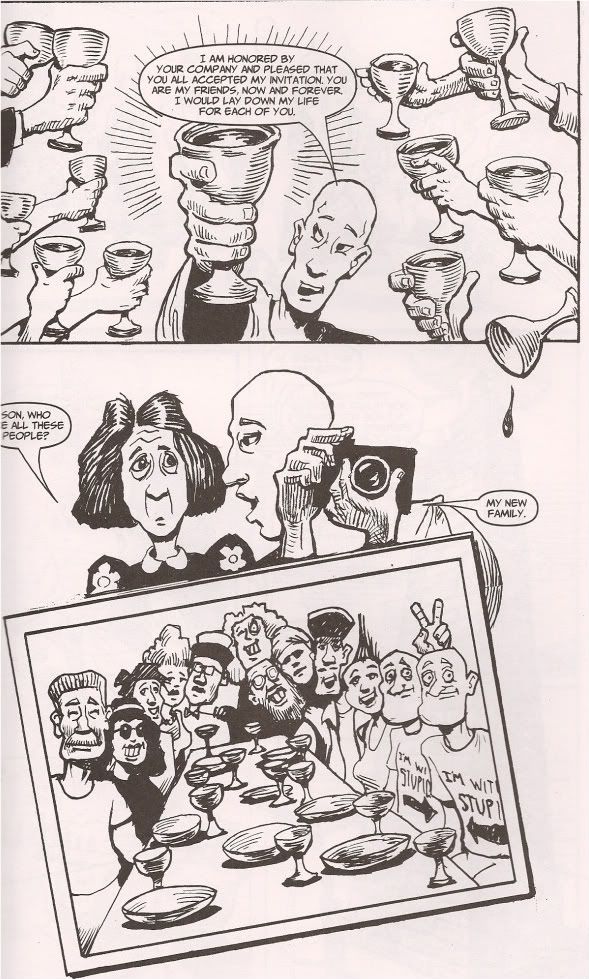
Marked is almost a chapter-by-chapter visual retelling of the Gospel. However, what makes this a fascinating interpretation is the visual choices Ross made to tell it. This is one of the best reasons religious materials make for good reading in the sequential art medium. Just as each Gospel writer portrays a slightly different view of Jesus and different aspects of Jesus were emphasized, Ross’s Marked tells the story of Mark, but adds a very different portrayal.
First of all, Jesus is not the Anglo-Saxon bearded savior that we’re all used to seeing. Ross draws Jesus as a bald, Asian man. This is not the only multicultural reference in the book. Ross makes the entire landscape a center of multiculturalism. The setting is a big city, much like New York, with characters from all walks of life. Every character of the story is played against type, yet is strangely accurate to the point Mark was trying to make. John the Baptist is a wild-eyed Igor, Mary Magdalene is an African-American woman, and Jairus is a celebrity hip-hop artist. Using these images of these characters, Ross makes the story relevant to our day and time.
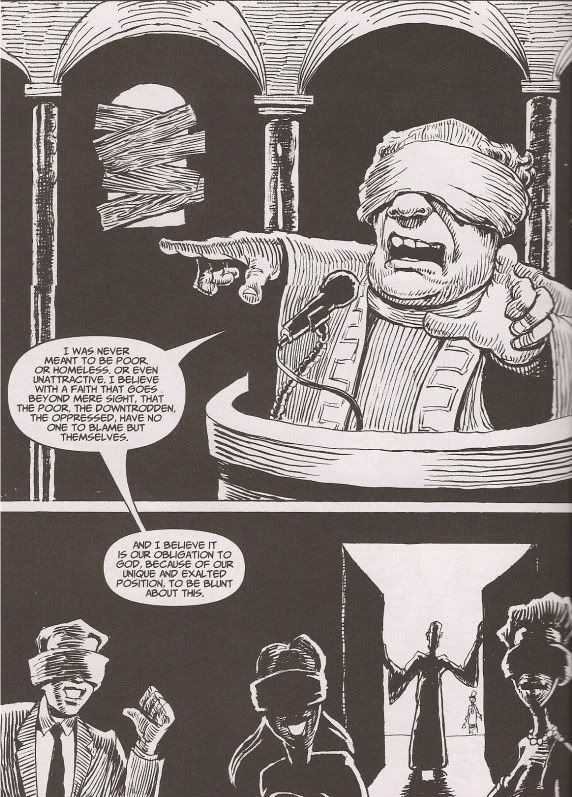 Jesus was certainly a radical in his time, especially to the religious leaders of the day. In Marked, the religious leaders are clearly dressed in liturgical garb, resembling Catholic or Episcopal priests, which causes the reader to suspect such “Pharisaical” behavior of our own religious leaders. Also, the supposed “religious” people are blindfolded, yet participate in the social aspect of church, sipping their martinis. Throughout the book, Jesus strips such people of their blindfolds, freeing them and literally helping them to see. This visual representation communicates the idea that even the so-called “religious” people are blind to the message Jesus comes to proclaim.
Jesus was certainly a radical in his time, especially to the religious leaders of the day. In Marked, the religious leaders are clearly dressed in liturgical garb, resembling Catholic or Episcopal priests, which causes the reader to suspect such “Pharisaical” behavior of our own religious leaders. Also, the supposed “religious” people are blindfolded, yet participate in the social aspect of church, sipping their martinis. Throughout the book, Jesus strips such people of their blindfolds, freeing them and literally helping them to see. This visual representation communicates the idea that even the so-called “religious” people are blind to the message Jesus comes to proclaim.
Jesus also frees numerous people from snake-like demons that are inside the individuals. Jesus fights some of them, yanking the demons out through people’s mouths. In Marked, evil exists inside the individual, festering like a cancer, yet can be extracted by Jesus. However, like the Gospel, the demons aren’t always vanquished. Like in the story of the Genesarene demoniac, Jesus sends the demons into a herd of pigs who then jump off the cliff. This is one of the only passages that Ross illustrates literally.
While everything in Marked is stylized and modernized, it also has its moments of surreality. Upon entering Jerusalem, Jesus meets the “Tree of Life” which represents the biblical story of the Fall of Adam and Eve found in Genesis. Jesus eventually turns the tree over when he causes a major ruckus in the temple.
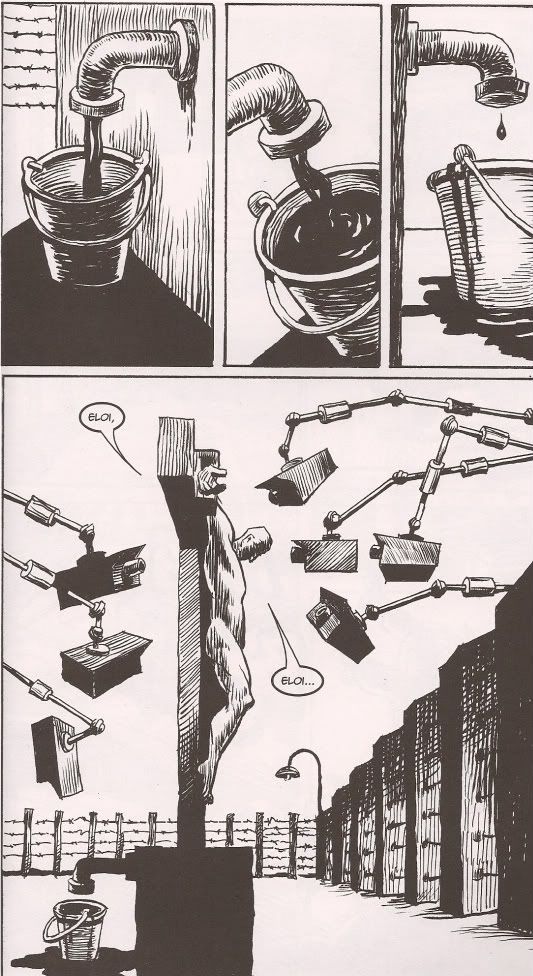 Perhaps the most poignant scene in the book is the death of Jesus, televised for all to see. Pontius Pilate is a television executive whose decision leads to Jesus’s death. Despite the television coverage, few people are actually present at the crucifixion, and some even think it’s a publicity stunt and nothing more.
Perhaps the most poignant scene in the book is the death of Jesus, televised for all to see. Pontius Pilate is a television executive whose decision leads to Jesus’s death. Despite the television coverage, few people are actually present at the crucifixion, and some even think it’s a publicity stunt and nothing more.
The end of Marked includes the Resurrection, but like the Gospel of Mark, ends abruptly. Before the additional endings of Mark, the scene ends mysteriously with the women at the empty tomb, but no explanation. Marked ends in the same way, with no easy answers as to what happens next.
I am not a fan of the art in this book, but I am intrigued by the choices Ross made to tell the story. There is lots of symbolism here, and the real theologian/art appreciator will find some things to chew on here. Some may find Marked offensive, which is exactly how the Gospel of Mark should be taken. Too often, biblical messages are sanitized for easy consumption.
If you would like to read the Bible, but have found it too often used as a weapon for hatred and prejudice, give Marked a try. Try to put away all the religious preconceptions you may have about Jesus and his story, and read this with a blank slate. I think you’ll enjoy it more.
In Marked, Jesus comes as a revolutionary, a healer, a preacher, a demon ass-kicker, and a social activist. For that, he gets killed. What happens next is anyone’s guess, but it sure is fun to play with that mystery.

Jeff Jackson
jeff@comicattack.net

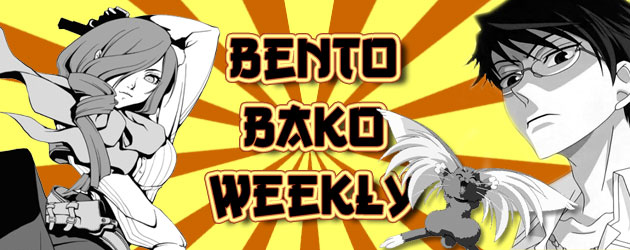
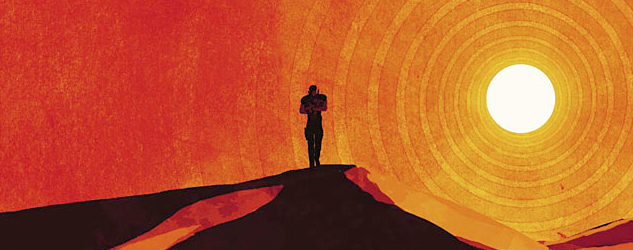
Jeff, this is unrelated to your column (which was a good read, btw), but I thought you might find it interesting.
http://www.msnbc.msn.com/id/34522514/ns/world_news-world_faith/
It’s a story about a UK priest who advises his congregation to shop lift from large retail chains if they are in dire straights. As an alternative to burglary, or larger crimes. He’s not condoning it, in fact he is adamant about it being a bad thing to do, but he’s making a comment on how society abandons people in need (those who have lost jobs, or are recently released from prison with nothing), and only leaves them with the option of theft.
It’s very Les Miserables…. It’s the same points Victor Hugo was trying to make in his novel, when a man in poverty stole a single loaf of bread to feed his starving children (well, his sister’s), and was thrown into prison for 20 or so years.
That’s a fantastic article, Kristen. What choice do some people have? I spent my morning today with a young, pregnant mother who’s husband cheated on her so she left and is living with family. She has no money for her other child’s Christmas. She called every church in our little town and I’m the only one who called her back. I’m very puzzled by this.
I don’t understand why we as a society are so reluctant to help the poor. I have many theories about this, of course.
At least that priest is raising the issue.
He is. And he’s getting slammed pretty bad for it. Everyone’s just focusing on “OMG he told people to steal!” Which is pretty predictable….
Good job Fj. It’s easy to see why some people just chastise or turn away from the poor or anybody in need. It’s the easier thing to do and human nature. That’s one of the things that should show people the difference between a christian and a non-believer. The willingness to help anyone, even your enemy. To put others before yourself, as Jesus did.
I know you meant it in jest, but comparing the Bible and its annexations to a DVD and extended footage was a brilliant comparison. How much of the Bible is made up of the actual writings of the supposed authors? Of course we can never know this for sure, but given the fact that the Bible only existed as tales spoken via oral tradition for generations, plus the number of times it had been translated over the years leads me to believe that not much of the original text has been preserved…not to mention they were first written 70 years after Christ’s death. So the Gospel writers weren’t even born yet when Christ died. I mean, imagine if someone today were to write about the events of 1940 as if he were actually there- only the internet, books, DVD’s, and history professors aren’t around to help them write…they just go off of what everyone else tells them. It’s a difficult pill to swallow.
Very interesting how the author chose to switch up the races of major biblical characters. It’s almost as if he’s saying it doesn’t matter what race these people were, but how they lived their lives. I like that.
“This visual representation communicates the idea that even the so-called “religious” people are blind to the message Jesus comes to proclaim.” AYO!! (except you of course)
: )
“Too often, biblical messages are sanitized for easy consumption.” We have another winner!!
“If you would like to read the Bible, but have found it too often used as a weapon for hatred and prejudice, give Marked a try. Try to put away all the religious preconceptions you may have about Jesus and his story, and read this with a blank slate. I think you’ll enjoy it more.” Ok, I like how this sounds. You win Jeff, I’ll give Marked a whirl!
You are pretty-spot on, Andy. To take the Bible seriously, one cannot simply say, “It’s the Word of God and it’s inerrant, period.” This stance disregards centuries of biblical interpretation, and misses the point. Christians have to understand that the Bible is an amalgamation of various authors, genres, forms, and styles, written for various ancient audiences. In my view, to say that Moses or Mark or Paul sat down one day and wrote the books of the Bible from start to finish with God whispering in their ears is like saying William Hung wrote, filmed, and directed the Star Wars saga.
Having said that, to me the miracle of Christian Scripture is that despite all of these factors, we have a decent canon which contains truths for us to live our lives by. To me, this is a higher regard for Scripture in that it takes seriously the “DVD extras” of the Bible. The Bible is a rich text, full of stories, poems, songs, legends, myths, letters, and histories. To simply look only at the surface of it misses the mark.
I’m teaching a class on Biblical Interpretation in January and Februrary, Andy. I think you’d like it.
“In my view, to say that Moses or Mark or Paul sat down one day and wrote the books of the Bible from start to finish with God whispering in their ears is like saying William Hung wrote, filmed, and directed the Star Wars saga.”
Again, this is a humorous analogy, but also one that shouldn’t be taken lightly. I’ve said it before Jeff: you’re a radical in your field, and a good one at that. I wish more religious faithful would look at the text the same way you do as opposed to pounding their war drums for future endeavors.
Is this class you’re teaching online?
Sorry, Andy. It’s not an online class. An online version would be fun to do though.
[…] Comics Are My Religion: Marked >> https://comicattack.net/2009/12/camr-marked >> http://www.churchofthe.net […]